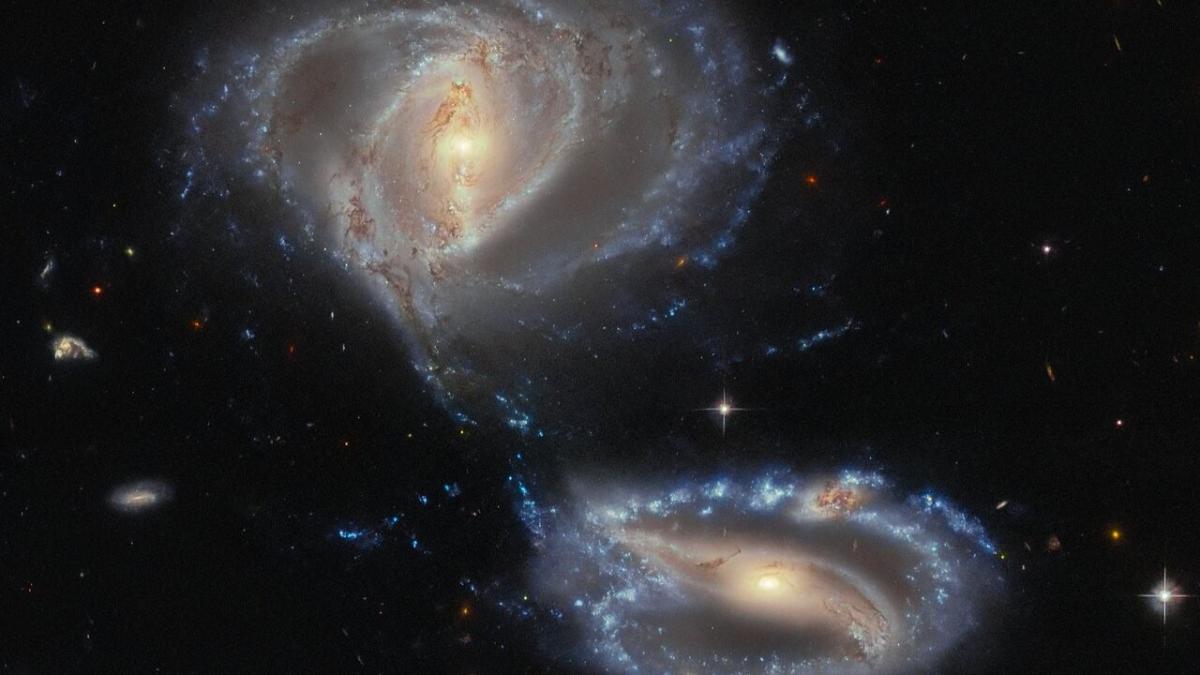
We think of galaxies as ancient. Our own galaxy, the Milky Way, formed 13.6 billion years ago, and the James Webb Space Telescope has allowed us to peer back to some of the first galaxies in the early universe. But are galaxies still being born today?
It’s a fun question to tackle because it lets us dig into the messy, complicated, beautiful process of galaxy formation. Let’s take a look at the possibilities.
First answer: No
Galaxies are pretty easy to identify. They are large collections of stars, gas and dark matter. They are largely distinct from one another; a typical galaxy is roughly 100,000 light-years across, while the typical distance between galaxies is roughly 1 million light-years.
Sometimes, galaxies merge or clump together inside clusters, but with a few exceptions, we can largely separate one galaxy from another. They’re like towns in the countryside: The distance between towns is larger than the towns themselves, so they’re easy to spot and define. Sometimes, towns bump up next to each other, and sometimes, a sprawling city consumes its neighbors. But by and large, a town is just a town.
Defining the start of a galaxy, however, is a different matter. Galaxies emerged in the early universe through a gradual process starting all the way back in the first second of the Big Bang. At that time, tiny pockets of higher-than-average density emerged and steadily grew over the next few hundreds of millions of years. At first, only the dark matter could pour in, as regular matter was busy getting tangled up with itself. But once the pockets of dark matter grew large enough, they drew in the surrounding regular matter.
As the regular matter gathered, it compressed, fragmented and gave light to the first stars. These protogalaxies went on to consume more gas, merge with neighbors and grow to become the fully formed galaxies we see today.
So, in many senses, no new galaxies appear today. The process of building them — of seeding them as tiny differences in density or the initial gathering of dark matter — is over and done with, an act that took place in the ancient cosmos and never again. There are no more protogalaxies — no more clouds of gas just waiting for the chance to compress and create a new galaxy — in the present-day universe.
When it comes to galaxies, what we see is what we get.
Second answer: yes
But that’s just one way to define the beginning of a galaxy. We can also look at another pivotal step: the appearance of the first stars. Going back to the city analogy, there’s a difference between when a city is first planned — its outlines defined with boundary markers and survey lines — and when the first people start moving in.
If we focus just on star formation, we see that this is an ongoing process that continues even into the modern-day universe. In recent years, astronomers have built a detailed understanding of a measure called the stellar mass function. This is a basic demographic census that maps how many stars are lighting up in each galaxy — or, put another way, how much mass is in the form of stars within each galaxy at different epochs in the universe.
Stars make up only a tiny percentage of a galaxy’s mass; the rest goes to dark matter and random clumps of gas. However, stars make a galaxy what it is, and they’re much easier to observe than any other galactic component.
With new surveys that have sampled galaxies across the universe, astronomers have recently discovered that the stellar mass function is going up across the board. This means that there are more small galaxies, medium galaxies and large galaxies than there were billions of years ago.
The new small galaxies don’t come from the emergence of protogalaxies in seeds of dark matter; they are already-existing clumps of material that are just beginning star formation. The larger galaxies, on the other hand, are driven mostly by the continued merger of smaller galaxies.
It won’t last forever
So, in at least one important way, new galaxies are continuing to appear on the cosmic scene as they light up with new rounds of star formation. They’ve always been there, hanging out for billions of years, but they’re just now making themselves visible. This process is viable because star formation is incredibly inefficient. Most of the gas within a galaxy will never turn into stars, and it can proceed for very long periods without using up much material — and it can take a galaxy a really long time to get started in the first place.
Related stories:
—How do we know how far away and early in the universe galaxies are?
—How do galaxies grow while ensnared in the universe’s cosmic web?
But sadly, the party won’t last forever. The problem is that not only is the universe expanding, but its expansion is accelerating — an effect known as dark energy. Although astronomers still don’t understand what drives dark energy, they can observe its effects on the rest of the universe: It’s spreading everything out.
As the universe ages, it’s harder and harder for material to clump together to form new galaxies and drive continued star formation. In fact, the peak of star formation passed billions of years ago. While new galaxies continue to light up, the rate of emergence is slowing down, with fewer and fewer new galaxies appearing every year.
We still have plenty of time — galaxies will continue forming stars for hundreds of billions of years to come — but we should still enjoy the party while it lasts.
EMEA Tribune is not involved in this news article, it is taken from our partners and or from the News Agencies. Copyright and Credit go to the News Agencies, email news@emeatribune.com Follow our WhatsApp verified Channel





